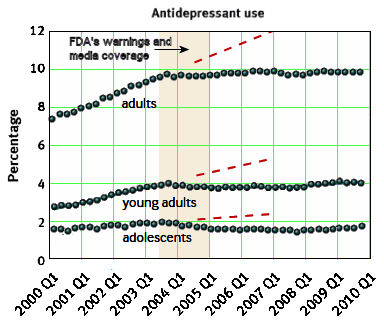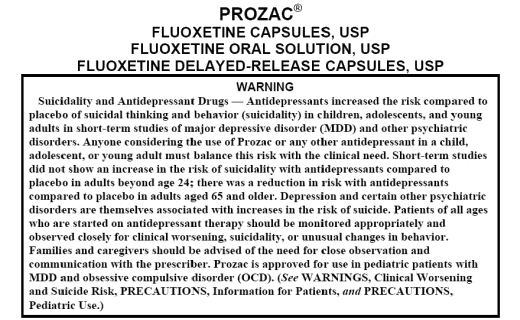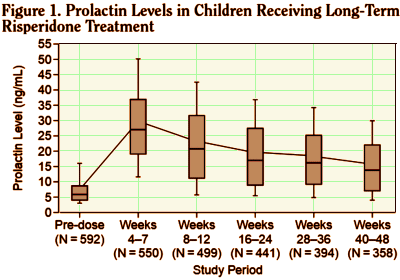Well, I didn’t plan it, but this post actually turns out to be a sequel [maybe prequel] to another post from two weeks ago [probably approximates zero…]. There, I was reporting on an analysis that showed that the major use of antipsychotics in children is not to treat psychosis, but rather to control disruptive impulsiveness in developmentally challenged children – aka behavior control. Remember that the first Atypical Antipsychotic, Risperdal®, came out of the gate looking for an FDA Approval for that very indication with a study by Janssen’s Risperidone Disruptive Behavior Study Group [Double-Blind, Placebo-Controlled Study of Risperidone for the Treatment of Disruptive Behaviors in Children With Subaverage Intelligence 2002] and were turned down. That study was later repurposed, ghost written, and republished under Dr. Joseph Biederman’s name to support a claim of efficacy in his proposed Bipolar Child diagnosis [Risperidone for the treatment of affective symptoms in children with disruptive behavior disorder: a post hoc analysis of data from a 6-week, multicenter, randomized, double-blind, parallel-arm study 2006]. Many of us believe that the Bipolar Child designation was more a rationalization to use Antipsychotics in children for behavior control than a valid psychiatric condition.
So this story is back on the front burner because of suits against Janssen by boys who developed gynecomastia [breast enlargement] while on Risperdal®. Back in the early days, the drug had been associated with elevated Prolactin levels – a sticking point brought up repeatedly by Janssen’s competitors. In 2003, Janssen published a study refuting the charge that their drug caused gynecomastia. Now one of the authors, Toronto Pediatric Endocrinologist Dr. Denis Daneman, is claiming that Janssen misled him when he was involved with that 2003 study:
Toronto Star
By David Bruser and Jesse McLean
July 31, 2015
A medical journal article co-authored by SickKids hospital’s top pediatrician was manipulated by a drug company and understated the risks of a powerful antipsychotic used to treat kids with behavioural problems, the former head of the U.S. drug regulator alleges. The 2003 article concluded there was no correlation between long-term use of Risperdal and an increased risk of certain side-effects, including the growth of breasts in boys. The listed authors included respected experts in the pediatric field — Toronto’s Dr. Denis Daneman and two U.S. doctors — and three employees from Janssen, which makes Risperdal.
The medical article was singled out in recent U.S. lawsuits against Janssen as an alleged example of drug company influence on doctors and published research. A court exhibit shows a draft of the study describing an association with certain side-effects — a finding that a Janssen employee internally flagged as “significant.” This information is not in the published version of the article.
“My name is on an article in which there is some data that has been left out. That, to me, crosses a line,” Daneman, pediatrician-in-chief at the Hospital for Sick Children, told the Star…
This is a story about the role of a drug company in the production of a scientific journal article. The alleged manipulation of the medical article is outlined in a report by expert witness Dr. David Kessler, former head of the U.S. Food and Drug Administration and a pediatrician by training. The report, filed in U.S. court, said Janssen “controlled and influenced” more than 40 manuscripts, including the one co-authored by Daneman. Kessler called the company’s alleged promotion of the drug for unapproved use in vulnerable children “deeply troubling”…
An independent biostatistician is now reanalyzing the 2003 study’s data to determine whether the original results stand or if they need to be corrected on the public record, Daneman said. “If, indeed, these allegations are true, then I would feel used,” he said, adding that his contributions to the paper “were made in good faith and based on the assumption that my colleagues and I had access to all the relevant data.” He said he was not included in internal Janssen discussions about certain revisions to the article. “There is this deception there that is intolerable,” he said…
In a 2012 deposition where he was questioned by a U.S. plaintiff’s lawyer, Daneman, a pediatric endocrinologist, agreed the study he participated in had data calculation errors that had the effect of understating the frequency of side-effects. In an interview with the Star, Daneman said there was no intent on his part to exclude significant results…
The 2003 study analyzed results from five Janssen clinical trials to investigate prolactin levels in children and teens taking Risperdal, and “explore any relationship with side-effects hypothetically attributable to prolactin.” Daneman said his role in the study was commenting on parts of the article and suggesting changes and that somebody else wrote it. He told the Star he was paid about $1,000 by Janssen for his participation. “I gave the money to charity because of the concerns that had been raised about potential conflicts of interest,” he said…
Let me say up front that I’m suspicious that this is an example of a "best defense is a good offense" trick, but I wanted to look at the original study Dr. Daneman signed on to. Notice that Drs. Robert Findling and Goedele De Smedt are also authors on the original 2002 study mentioned above:
by Findling, Kusumakar, Daneman, Moshang, De Smedt, and Binder.
Journal of Clinical Psychiatry. 2003 64[11]:1362-1369.
BACKGROUND: This analysis was designed to investigate prolactin levels in children and adolescents on long-term risperidone treatment and explore any relationship with side effects hypothetically attributable to prolactin [SHAP].
METHOD: Data from 5 clinical trials [total N = 700] were pooled for this post hoc analysis. Children and adolescents aged 5 to 15 years with subaverage intelligence quotients and conduct or other disruptive behavior disorders received risperidone treatment [0.02-0.06 mg/kg/day] for up to 55 weeks. Outcome measures analyzed included serum prolactin levels, reported adverse events, and the conduct problem subscore of the Nisonger Child Behavior Rating Form.
RESULTS: Mean prolactin levels rose from 7.8 ng/mL at baseline to a peak of 29.4 ng/mL at weeks 4 to 7 of active treatment, then progressively decreased to 16.1 ng/mL at weeks 40 to 48 [N = 358] and 13.0 ng/mL at weeks 52 to 55 [N = 42]. There was no relationship between pro-lactin levels and age. Females returned to a mean value within the normal range [</= 30 ng/mL] by weeks 8 to 12, and males were close to normal values [</= 18 ng/mL] by weeks 16 to 24. At least 1 SHAP was reported by 13 [2.2%] of 592 children. There was no direct correlation between prolactin elevation and SHAP.
CONCLUSION: With long-term risperidone treatment in children and adolescents, serum prolactin levels tended to rise and peak within the first 1 to 2 months and then steadily decline to values within or very close to the normal range by 3 to 5 months.
Side Effects Hypothetically Attributable to Prolactin [SHAP] is a mouthful. This from the Outcome measures section of the paper:
Patients with SHAP were classified according to 2 sets of criteria, SHAP[A] and SHAP[B]. The criteria used to define the SHAP[A] population were breast enlargement [gynecomastia], amenorrhea, menorrhagia, lactation nonpuerperal, menstrual disorder, and vaginal hemorrhage. An alternate definition of SHAP was used for the SHAP[B] population. SHAP[B] excluded males 10 years or older with gynecomastia, females with less than 31 days of breast enlargement [gynecomastia], and females with amenorrhea < 1 week. It is considered normal for males to have gynecomastia at some point in the evolution of puberty, with the frequency estimated as high as 50%. Adolescent gynecomastia may be unilateral or bilateral, occurs most frequently during stages 3 and 4 of puberty, and lasts a few months to 2 years [in one series, 27% of cases lasted 1 year and 7% lasted 2 years]. Females during puberty tend to experience breast enlargement and irregular menstrual cycles, and therefore these symptoms were not classified as SHAP.
The only two mentions of Denis Daneman ["D.D."] in the paper were with Thomas Moshang ["T.M."], a full time Janssen employee…
There are no data in children as to the degree of prolactin elevation that warrants concern in relationship to potential inhibition of growth or sexual development or potential side effects, such as gynecomastia or galactorrhea. It is the experience of the authors [pediatric endocrinologists T.M. and D.D.] that prolactin levels above 18 ng/mL but below 30 ng/mL are rarely, if ever, associated with clinical manifestation or alterations of the hypothalamic-pituitary-gonadal axis. Prolonged elevations of prolactin approaching serum concentrations of 100 ng/mL warrant careful clinical investigation.
…and…
The first analysis, SHAP[A], used a more inclusive definition of SHAP, and the second analysis, SHAP[B], excluded additional symptoms that the pediatric endocrinologist authors [T.M. and D.D.] attributed to puberty. SHAP[A] included gynecomastia irrespective of age, amenorrhea, menorrhagia, breast enlargement, lactation nonpuerperal, menstrual disorder, and vaginal hemorrhage. Dysmenorrhea during puberty was excluded.
Notice the absence of references. Dr. Daneman’s opinion in concert with that of an industry doctor basically threw out the symptom that mattered.
My point in this post isn’t just about Dr. Daneman’s culpability in this obviously wrongly interpreted study twelve years ago. He was a key link in Janssen’s campaign to maximize its Risperdal® profits by developing an off-label pediatric market. I admit that this is a particular sticking point for me. I sat through the TMAP trial in 2012 and listened to drug reps and marketing managers describe campaigns targeting child psychiatrists and pediatricians to use Risperdal® off label – campaigns based on outright lies [see on every call…]. But my main point is Dr. Daneman’s argument that Janssen with-held evidence from him. It wasn’t his fault, he didn’t write that paper. He just commented on it. He even gave away the money he received.
If what he says is true, he is guilty of two sins instead of just one. His name was on that author line, and his excuse is that he didn’t bother to look into the anything substantive about the paper? an industry funded study? with his industry paid colleague? for which he was being paid outright?
Daneman said his role in the study was commenting on parts of the article and suggesting changes and that somebody else wrote it.
That’s no excuse at all, and speaks to the essence of the meaning of the word author:
au·thor [

]
noun
One that creates, founds, or originates:
That’s what happened in all these despicable articles that we talk about here and elsewhere.
The authors weren’t authors. They signed on to professionally written industry jury-rigged papers without really involving themselves with their creation, or their veracity. Dr. Daneman didn’t embrace his authorship on this paper. It was used by Janssen to keep their campaign alive to sell
Risperdal® off label for managing retarded kids behavior, now apparently the main pediatric use for the drugs [
probably approximates zero…]. He was used as a ticket into a journal with an unsubstantiated opinion disembodied from the study itself – and the ripples are still being felt years later, billions of dollars later, a group of boys with female breasts later.
His excuse is his biggest indictment…
 ry agent, or physical therapy, or even putting on a plaster cast. "It depends…" introduced the answers to most questions in the Rheumatology Clinic. The attendings made up for the lack of precision by being very careful – taking careful histories, doing careful exams, making careful treatment choices – and the best lesson of all, carefully following up their interventions. Every treatment was considered to be a therapeutic trial.
ry agent, or physical therapy, or even putting on a plaster cast. "It depends…" introduced the answers to most questions in the Rheumatology Clinic. The attendings made up for the lack of precision by being very careful – taking careful histories, doing careful exams, making careful treatment choices – and the best lesson of all, carefully following up their interventions. Every treatment was considered to be a therapeutic trial. I found that if I tried a medication, they rarely took it for much past the first pill. Feeling any medication effect scared them, and they stopped – even with the minor tranquillizers. I read that SSRIs were supposed to help. But one is rarely helped by a medication you won’t take. I began to start them on homeopathic doses, thinking I could sneak my way up after a time of acclimation. So I would start with 5 mg of Citalopam for example. To my surprise, they returned, saying it helped. In cases where I added a Benzo as a prn for anxious situations, the same thing happened. So I prescribed half of an 0.25mg Aprazolam, and heard the same report. 5mg Citalopam? 0.125mg Aprazolam? Who’d have thought? Over the years, I’ve seen enough of these patients, and written enough of these mini-dose prescriptions, to see that as the way to treat such cases straight away. I still do my "therapeutic trial" thing, but in these patients, it always seems to come out the same. I have no clue about the why? of it.
I found that if I tried a medication, they rarely took it for much past the first pill. Feeling any medication effect scared them, and they stopped – even with the minor tranquillizers. I read that SSRIs were supposed to help. But one is rarely helped by a medication you won’t take. I began to start them on homeopathic doses, thinking I could sneak my way up after a time of acclimation. So I would start with 5 mg of Citalopam for example. To my surprise, they returned, saying it helped. In cases where I added a Benzo as a prn for anxious situations, the same thing happened. So I prescribed half of an 0.25mg Aprazolam, and heard the same report. 5mg Citalopam? 0.125mg Aprazolam? Who’d have thought? Over the years, I’ve seen enough of these patients, and written enough of these mini-dose prescriptions, to see that as the way to treat such cases straight away. I still do my "therapeutic trial" thing, but in these patients, it always seems to come out the same. I have no clue about the why? of it.  What brought it to mind was seeing a patient in the clinic who I now only see every three months for refills. She was one of the first I tried on these baby doses. She is now working part time and proudly announced that she hadn’t been to the Emergency Room for over a year. Both things are major accomplishments. She was downright effusive about how much better her life is. I rarely have very much good to say about our medications, so I made a mental note to write about it – I guess to prove I’m no therapeutic nihilist.
What brought it to mind was seeing a patient in the clinic who I now only see every three months for refills. She was one of the first I tried on these baby doses. She is now working part time and proudly announced that she hadn’t been to the Emergency Room for over a year. Both things are major accomplishments. She was downright effusive about how much better her life is. I rarely have very much good to say about our medications, so I made a mental note to write about it – I guess to prove I’m no therapeutic nihilist.






